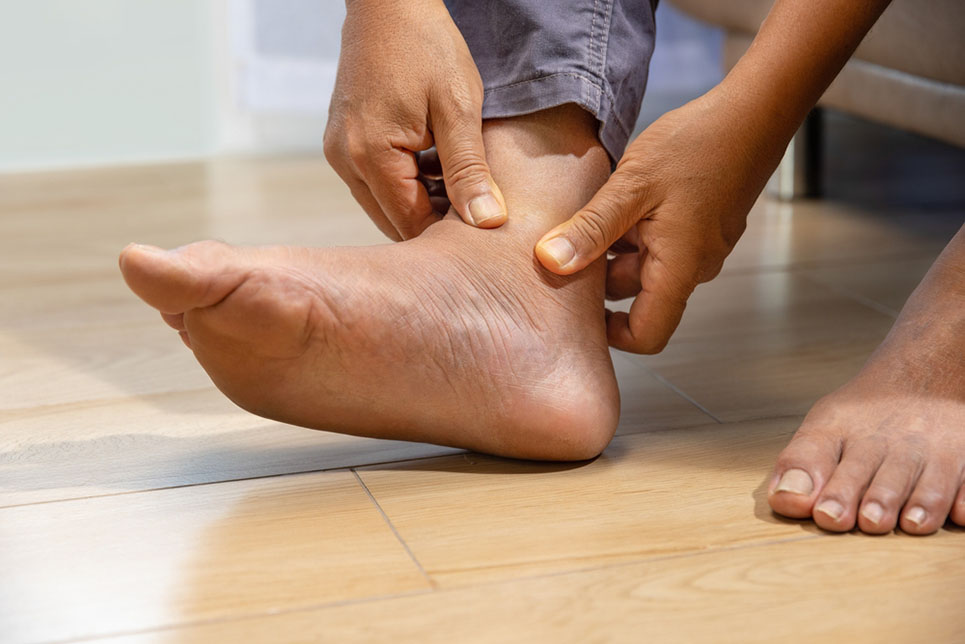Swelling Feet and Ankles in Heat: Why and How to Solve
By Toa55 / Shutrstock.com
Swollen feet and ankles are some of the more unpleasant signs of summer. While most cases are minor and easily ignored, seriously swollen can be uncomfortable and even painful. Thankfully, there are many things that you can do to prevent and treat swollen feet at home, from wearing adaptive footwear to eating less sodium. Here’s what you need to know about why your feet and ankles swell in the heat:
Why Do My Ankles & Feet Swell in the Heat?
Heat causes the blood vessels in your body to dilate, or get wider. When this happens, fluids can leak out of your capillaries, causing swelling. Gravity also worsens this effect by pulling blood and other fluids toward the ground. This is why you will often notice swelling in your ankles and feet first, as opposed to your upper body.
Edema is the medical word for swelling, and swelling caused by hot temperatures is technically called heat edema. Heat edema typically manifests in the ankles, feet and calves, but you might notice it in other areas of the body as well. Heat edema may affect just one limb, or both limbs at the same time — so you might notice that only one of your feet is swelling while the other looks relatively normal. For more information about possible reasons for swollen feet, check out our guide that explains what causes feet to swell in the elderly.

By JulieK2 / Shutterstock.com
How to Stop Ankles & Feet from Swelling
While you might not be able to prevent all swelling, there are definitely things that you can do to help prevent your ankles and feet from swelling as much in the summer heat. Limiting your heat exposure and spending most of your time inside with air conditioning will help to prevent swelling; keeping cool will discourage your blood vessels from dilating.
Wearing compression socks can also prevent swelling. Compression stockings apply gradual pressure to the leg to encourage healthy blood flow and discourage swelling. For best results, put on the compression socks in the morning before your feet and ankles start to swell, and then wear them throughout the day. Pair them with shoes for swollen feet that feature adjustable velcro tabs for the ultimate comfort footwear.
Standing and walking a lot will cause your feet to swell no matter what, and the heat only makes it worse. Try not to spend too much time on your feet, especially standing in one place. If you typically sit most of the day, change position often and get up at least once an hour to walk around so blood and excess fluids don’t pool in your legs. If you plan to be on your feet for a long period of time, be sure to have the right footwear such as mesh shoes or open toed sandals. Having the correct footwear can help prevent puffy feet and lead to improved foot health
If you’re going to be in hot weather, be sure to drink plenty of water, since your body will have better fluid retention if you get too dehydrated. Avoid foods and drinks that can act as diuretics , such as those high in alcohol, caffeine, sugar and sodium. Eat foods that are rich in water and nutrients, such as produce, to stay even more hydrated. Staying hydrated and keeping a nutrient heavy diet is a great way to help prevent ankle swelling and foot swelling.

By Mallmo / Shutterstock.com
How to Soothe Swollen Feet & Ankles
If your feet are already swollen, there are several things that you can do at home to help combat the poor circulation, fluid buildup or any other cause of your swollen feet. Taking a cold bath or shower is a great way to soothe swelling. Avoid hot water, which will cause the blood vessels to dilate further and worsen the swelling. You can also apply ice packs or cold compresses to the affected area to bring the swelling down more rapidly.
Once you are dried off, try lying down on your back with your feet elevated on two to three pillows. Your feet should be above the level of your heart for best results so that gravity can help the fluid drain back toward your torso. Lie in this position for a minimum of 15 minutes until your feet start to feel better and the swelling begins to go down. You can also try gently massaging your feet and legs to stimulate circulation.
If your swollen feet and ankles persist despite your best efforts, then you might want to see your doctor. There can be underlying medical conditions or causes for swollen ankles and feet, including medication side effects, too much sodium in the body and venous insufficiency. Your doctor will work with you to get an accurate diagnosis and devise a course of treatment that will fix the underlying issue.
Ready to get some adaptive footwear for summer? Browse shoes for seniors at the Silverts store, including wide sizes and styles for both men and women. Order today and get free shipping on your domestic U.S. order!
Sources:
Birmingham, Foot Specialists Of. “Why Heat Makes Your Feet Swell—and How to Deal With It.” Foot Specialists of Birmingham, 10 Sept. 2023, bhamfoot.com/why-heat-makes-your-feet-swell-and-how-to-deal-with-it.
How to Stop Feet Swelling in Hot Weather: Effective Solutions to Beat the Heat | Modern Foot and Ankle. www.modernfootankle.com/resources/foot-care/guides/swelling-in-hot-weather.





No Comments